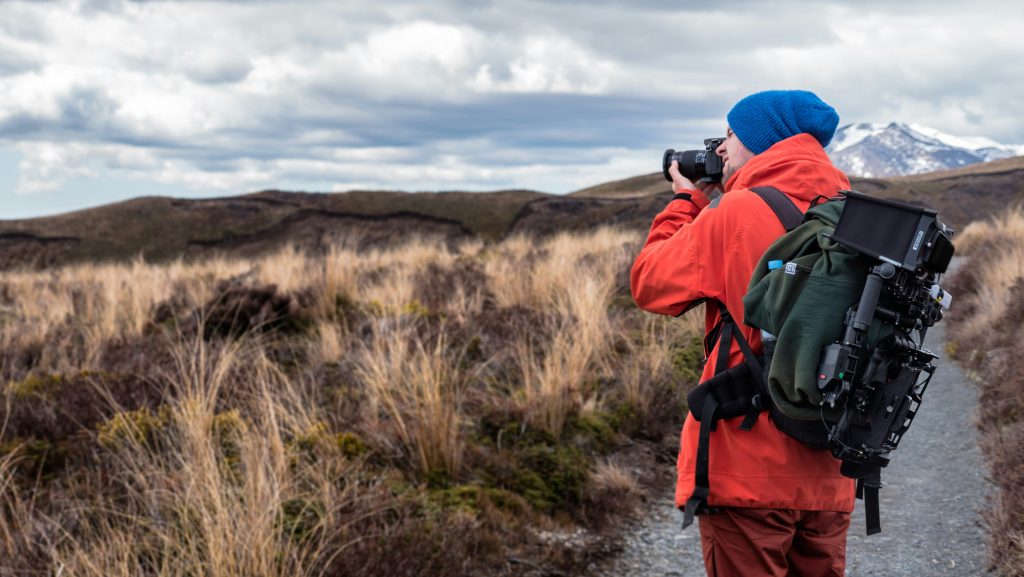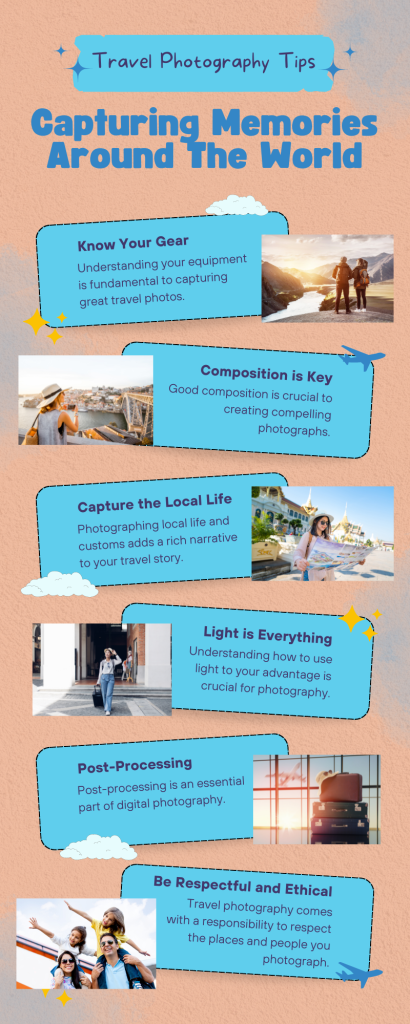Traveling the world is an exhilarating experience, offering endless opportunities to capture stunning photographs that tell the story of your journey.
Travel photography allows you to freeze moments in time, creating a visual diary of the cultures, landscapes, and people you encounter.
Whether you are a seasoned photographer or a beginner with a smartphone, these travel photography tips will help you take captivating photos that preserve your memories and inspire others.
8 Tips To Master Travel Photography
Mastering travel photography involves a combination of technical skills and creative vision. Here are 8 essential tips to elevate your travel photography game and capture breathtaking memories on your journeys.
1. Know Your Gear

Understanding your equipment is fundamental to capturing great travel photos. Whether you’re using a DSLR, a mirrorless camera, or a smartphone, familiarize yourself with the settings and capabilities of your device.
Cameras
For those using DSLR or mirrorless cameras, learning the basics of aperture, shutter speed, and ISO will significantly enhance your ability to take control of your shots.
Invest in a versatile lens, such as a 24-70mm, which is suitable for a wide range of scenarios from landscapes to portraits. Don’t forget to bring extra batteries and memory cards, as you might be away from charging points for extended periods.
Smartphones
Modern smartphones come equipped with impressive cameras. Make the most of the built-in features like HDR, portrait mode, and panorama. Consider investing in clip-on lenses for added versatility. Remember to keep your lens clean and carry a portable charger to ensure your phone stays powered throughout your adventures.
2. Research Your Destination

Researching your destination before you arrive can greatly enhance your photography. Understanding the local culture, customs, and significant landmarks helps you plan your shots and ensures you don’t miss any must-see locations.
Landscapes and Landmarks
Identify the best times of day to visit popular landmarks to avoid crowds and get the best light. Golden hour (shortly after sunrise and before sunset) offers soft, warm lighting that is perfect for photography.
Blue hour (just before sunrise and after sunset) provides a beautiful, diffused light ideal for cityscapes and landscapes.
Cultural Sensitivity
Be aware of cultural sensitivities regarding photography. In some cultures, taking photos of people, religious sites, or certain events may be inappropriate or require permission. Always ask for consent before photographing individuals and respect any restrictions.
READ MORE: 10 Must-Have Travel Essentials: Elevate Your Adventures With These Travel Essentials
3. Composition is Key

Good composition is crucial to creating compelling photographs. Follow these basic principles to improve your shots:
Rule of Thirds
Imagine your frame divided into nine equal parts by two horizontal and two vertical lines. Placing your subject along these lines or at their intersections creates a balanced and visually appealing composition. Most cameras and smartphones have a grid option to help you apply this rule.
Leading Lines
Use natural lines to lead the viewer’s eye through your photo. Roads, rivers, bridges, and pathways are excellent examples of leading lines that can add depth and direction to your composition.
Framing
Framing involves using elements within the scene to frame your subject. Archways, windows, and trees can create a natural frame around your subject, drawing attention to it and adding context to the image.
Foreground Interest
Including an interesting element in the foreground can add depth to your photos. It provides a sense of scale and draws the viewer into the scene, making your landscape shots more engaging.
4. Capture the Local Life

Photographing local life and customs adds a rich narrative to your travel story. Street photography, portraits, and candid shots of daily activities can be particularly powerful.
Street Photography
Street photography captures the essence of a location. Blend into the background and observe the scene before taking your shot. Look for interesting interactions, vibrant markets, and unique architecture. Be quick and discreet to capture genuine moments without intruding.
Portraits
When photographing people, engage with your subjects and build a rapport before taking their photo. A genuine smile or an interesting story can make your portrait more compelling. Use a wide aperture (low f-number) to blur the background and focus on your subject.
Candid Shots
Candid photography involves capturing unposed moments. These photos often tell the most authentic stories. Keep your camera ready and be patient, waiting for those spontaneous moments that encapsulate the spirit of a place.
5. Light is Everything

Lighting can make or break a photograph. Understanding how to use natural light to your advantage is crucial for travel photography.
Golden and Blue Hours
As mentioned earlier, the golden and blue hours provide the best natural light for photography. Plan your shoots around these times to capture stunning landscapes and portraits.
Harsh Light
Midday sun can create harsh shadows and overexposed highlights. If you must shoot during this time, look for shaded areas or use a polarizing filter to reduce glare. Alternatively, embrace the harsh light to create dramatic contrasts and silhouettes.
Night Photography
Night photography presents unique challenges and opportunities. Use a tripod to keep your camera steady for long exposures.
Experiment with different shutter speeds to capture light trails from traffic or the serene glow of city lights. Don’t forget to adjust your ISO settings to maintain image quality.
READ MORE: The Ultimate Guide To Sustainable Travel Practices: 6 Best Tips
6. Tell a Story

A great travel photograph does more than just capture a scene; it tells a story. Think about the narrative you want to convey through your images.
Series of Shots
A series of photos can effectively tell a story. Capture the wide-angle view of a location, then zoom in on the details, and finally, include portraits or candid shots of people interacting with the environment. This approach provides a comprehensive view of your travel experience.
Details Matter
Pay attention to the small details that define a place. Textures, patterns, colors, and unique objects can add depth to your travel story. These shots are great for adding variety to your photo album and highlighting the nuances of your destination.
Emotion and Connection
Photos that evoke emotion resonate more with viewers. Capture moments that convey joy, curiosity, tranquility, or any other emotions you encounter.
Establishing a connection with your subject, whether it’s a person, an animal, or a landscape, will result in more powerful and engaging photographs.
7. Post-Processing

Post-processing is an essential part of digital photography. It allows you to enhance your images and correct any issues that occurred during shooting.
Basic Adjustments
Start with basic adjustments such as exposure, contrast, and white balance. These tweaks can significantly improve the overall look of your photo.
Tools like Adobe Lightroom and Photoshop offer comprehensive editing options, but there are also user-friendly mobile apps like Snapseed and VSCO.
Enhancing Colors
Adjust the saturation and vibrance to make colors pop, but be cautious not to overdo it. Subtlety is key to maintaining a natural look. You can also use selective color adjustments to enhance specific parts of your image.
Sharpening and Noise Reduction
Sharpening helps to enhance the details in your photo, while noise reduction can improve the quality of images taken in low light. Strike a balance between the two to avoid making your image look unnatural.
Creative Edits
Experiment with creative edits to give your photos a unique touch. Black and white conversions, split toning, and vignettes can add an artistic flair to your travel photos.
However, always remember that less is more—don’t let editing overshadow the original beauty of the image.
8. Be Respectful and Ethical

Travel photography comes with a responsibility to respect the places and people you photograph. Ethical considerations should always guide your actions.
Respect Privacy
Always ask for permission before photographing people, especially in private or sacred spaces. Respect their wishes if they decline.
Cultural Sensitivity
Be mindful of local customs and traditions. Avoid taking photos in places where it is forbidden or considered disrespectful.
Educate yourself about the cultural significance of certain practices and sites to avoid inadvertently causing offense.
Environmental Responsibility
Leave no trace of your presence. Avoid damaging natural sites or wildlife for the sake of a photograph. Stay on marked paths and follow guidelines to preserve the beauty of the places you visit for future generations.
READ MORE: The Ultimate Traveler’s Guide: Top-Rated Hotels Worldwide
Conclusion
Travel photography is a rewarding endeavor that allows you to capture and share the essence of your journeys.
By understanding your gear, researching your destination, mastering composition, and using light effectively, you can take stunning photos that tell compelling stories.
Remember to be respectful and ethical in your approach, ensuring that your photography honors the people and places you visit.
With these tips, you’re well on your way to creating a visual diary of memories that will last a lifetime. Happy shooting!
FAQs (Frequently Asked Questions)
1. What are the don’ts of travel photography?
A: Don’t intrude on local privacy, disrespect cultural norms, or rely solely on selfies.
2. How to take travel pics?
A: Take travel pics by focusing on composition, using natural light, and capturing candid moments.
3. What are the 3 most important things in photography?
A: The three most important things are lighting, composition, and storytelling.
4. How would you describe travel photography?
A: Travel photography captures the essence of a destination, including its landscapes, people, and culture.


